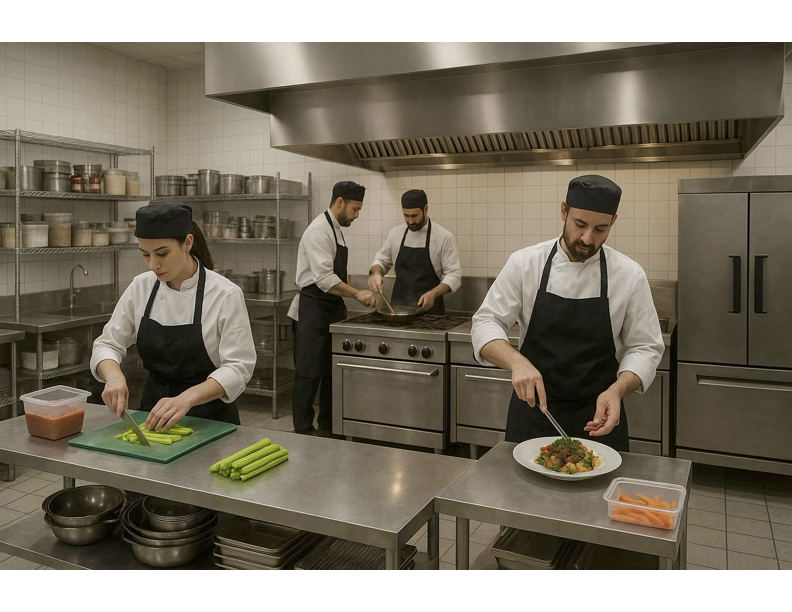A commercial kitchen isn’t just a bigger version of your home kitchen. It’s a high-performance workspace designed to handle volume, speed, safety, and efficiency. Whether it’s a bustling restaurant, a catering hub, or a ghost kitchen, certain core features are non-negotiable. Here’s what separates a functional commercial kitchen from a chaotic one.
1. Workflow-Driven Layout
A commercial kitchen has to run like clockwork. That starts with a layout that mirrors the workflow:
-
Receiving & Storage: Efficient kitchens start with space to receive deliveries and store dry, refrigerated, and frozen goods.
-
Prep Stations: Designated areas for washing, chopping, and assembling ingredients help prevent bottlenecks.
-
Cooking Line: The heart of the kitchen, equipped with stoves, ovens, fryers, and grills—usually arranged in a line or U-shape to keep movement tight and efficient.
-
Plating & Pass-Through: A clean area where dishes are finished and handed off to servers or delivery runners.
A well-planned layout cuts down on steps, improves communication, and prevents cross-contamination.
2. Industrial-Grade Equipment
Consumer-grade appliances can’t keep up in a commercial setting. Kitchens need:
-
Heavy-duty ranges, fryers, ovens, and griddles built to handle nonstop use.
-
High-capacity refrigeration and freezers to store bulk ingredients safely.
-
Commercial dishwashers that sanitize fast and thoroughly.
-
Ventilation systems to manage heat, smoke, and grease—keeping both air quality and safety in check.
Every piece needs to be reliable, easy to clean, and compliant with health and fire codes.
3. Food Safety Infrastructure
Health inspectors aren’t optional. Commercial kitchens are legally bound to meet strict standards:
-
Handwashing sinks in every prep zone.
-
Separate stations for raw and cooked items to prevent cross-contamination.
-
Proper cold and hot holding equipment to keep food out of the “danger zone” (40°F–140°F).
-
Sanitation stations and clearly labeled cleaning supplies.
Food safety isn’t just about rules—it protects customers and your reputation.
4. Smart Storage Solutions
A place for everything, and everything in its place. That’s not just a motto—it’s a survival strategy. Essential storage includes:
-
Dry storage with labeled shelving and pest control.
-
Cold storage with temperature logs and clear labeling systems.
-
Cookware and smallwares organized by station, within arm’s reach of where they’re used.
Poor storage leads to waste, confusion, and delays. Smart storage keeps the kitchen moving.
5. Fire and Safety Systems
Commercial kitchens are fire-prone environments. Safety must be built in:
-
Fire suppression systems (typically integrated into hoods).
-
Emergency shutoff valves for gas lines.
-
Slip-resistant floors and clear walkways.
-
Proper lighting for all work zones.
Operators are also responsible for training staff on emergency procedures and first aid.
6. Scalability and Flexibility
Trends shift, menus change, and businesses grow. A great kitchen is built with flexibility in mind:
-
Modular equipment that can be moved or replaced as needed.
-
Multi-purpose prep areas that can serve different functions across shifts.
-
Space for future upgrades, like new tech or additional cooking lines.
What works now may not work in six months—so plan ahead.
7. Technology and Systems
Efficiency isn’t just physical—it’s digital. Modern commercial kitchens rely on:
-
Kitchen display systems (KDS) to streamline orders.
-
Inventory management software to track stock and reduce waste.
-
Temperature sensors for constant monitoring.
-
POS integration to sync front-of-house with back-of-house seamlessly.
Technology reduces errors and gives managers data they can act on.
Final Thought
A commercial kitchen is a production engine. Every square foot and every tool must earn its place. Design it for speed, build it for safety, and run it with precision. Whether you’re starting from scratch or optimizing an existing space, focusing on these core features is the key to a kitchen that performs under pressure.

